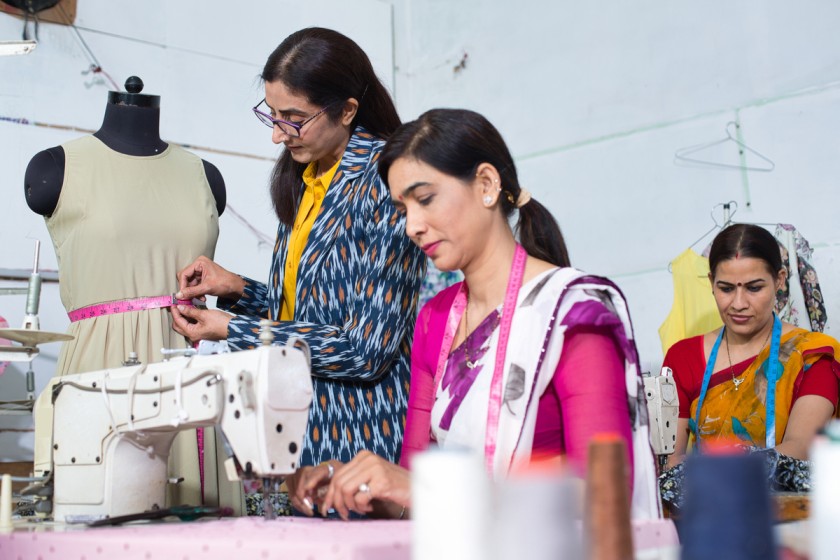The Garment Industry Development Corporation Case Study



The GIDC, also known as the Garment Industry Development Corporation, is a corporation that was established in 1984 to revitalize and renew the clothing industries in the Garment District of New York City that were in a state of rapid decline. This corporation was a rare collaboration between New York City’s garment industry, the state government, and the local garment trade union.
During the initial stages, GIDC was solely concerned about reviving the garment sector in the city and saving the employment of more than 100,000 workers who were associated with this sector. However, with time the corporation developed into a new and different kind of employment development agency that took up varied sectoral initiatives to fulfill their goals and keep the Garment District thriving.
THE CHALLENGE
When the Garment Industry Development Corporation started functioning in New York City’s Garment District, it had a clear goal in mind – to employ low-income workers, train them, and help them earn higher wages. However, the execution of this end goal was still unplanned. The GIDC was faced with a huge roadblock – a wave of offshore, low-wage competition. A large population of NYC immigrant residents found easy entry into New York’s garment industry. The traditional labor requirement depended on hiring cheap labor, rather than efficient skills and processes. Hence, the city’s garment sector was constantly stuck in a low-skill and low-productivity zone. Therefore, the primarily female labor unions were most concerned with their wages. Many of them, although highly skilled in their operations, were finding it difficult to make ends meet.
However, the challenge for GIDC was even bigger. Most of the businesses in the Garment District were family-owned shops that could hardly afford to pay higher wages to their employees. They were in flux to fulfill the ever-increasing demands of powerful retailers who dominated the market.
The GIDC sponsors realized that tried-and-tested methods of the conventional job training model of upskilling workers by them training for high-wage jobs would not work in this situation. It was not a normal supply problem that would be solved by merely providing high-skilled workers to the apparel sector, as the industry’s profitability problem was not primarily based on inadequate training. It was a situation where neither focusing on the labor end of the issue nor the manufacturing end would provide the desired results. So, the GIDC shifted focus towards the competitive niche that New York enjoyed in global markets and began to create ways to capitalize on the opportunities that it offered.
THE SOLUTION
To solve this problem, the garment industry, as a whole, needed to be repositioned and restructured. The GIDC had to convince factory owners in the Garment District to invest in new and upgraded production machinery. They needed to sensitize the owners towards replacing old methods and using their workers to facilitate new and faster processes. The garment sector’s collaborative advantages were required to be analyzed, and new market niches and alliances had to be exploited to their full extent. Thus, the GIDC came up with an integrated, systemic view of the entire garment sector by using a novel method that is now known as the sectoral approach.
As a sectoral initiative, the garment industry:
· Focuses on a particular occupation or set of occupations within the industry at any given time. The GIDC targets a particular range of occupations within the garment industry, including pressing, cutting, sewing, machine repair, and maintenance. For example, it created a tie-up with the Super Sewers Program to provide uniquely designed training for sewing machine operators to target the largest worker base within the garment sector.
· Intervenes within the functioning of the industry to facilitate the employment of the targeted occupation. The corporation intervenes within the garment industry on various levels, providing training services as well as marketing and technical assistance to the businesses. It also helps businesses by linking them to new markets, thereby becoming a valued contributor to New York City’s garment industry.
· The corporation’s sole existence depends on the primary purpose of assisting the low-income society in finding decent employment. The GIDC targets low-income groups and helps them to upgrade their skills for them to obtain full-time employment and earn wages that will help them run their families.
· Gradually establishes a systemic change within the targeted occupation’s labor market. The GIDC creates a systemic change in numerous ways. It links firms to new buyers and aims to introduce new production methods and technologies to the industries to advance their competitiveness and efficiency. By undertaking these tasks, the corporation has made sure to change the view of the garment industry in the eyes of the state, city, and federal officials, establishing its competitive and profitable nature.
THE IMPLEMENTATION

To make the sectoral model work, the organization had to conduct studies to gain an insight into performance and finance-related information. However, the traditionally minded garment sector was not actively eager to offer this without establishing a level of trust. Thus, the GIDC has to create coalitions and earn the trust of the key players by proving itself as a credible and unbiased representative of the sector’s strategic interests. To make the sectoral model function smoothly, the GIDC came up with various training that drew into the strengths of the sectoral approach. Some of the training on the supply side were:
1. The Super Sewers Course – It offered 240 hours of sewing training to laid-off workers four times every year.
2. The Apparel Skills Course – A set of continuously updated part-time courses for employed workers in specific areas.
3. On-site training – Practical training on the employer floor for hands-on experience.
On the demand side, it:
1. Provides technical consultation that focuses on engineering assistance, needs assessment, and quality control training.
2. Market development services that provide export, import, and marketing assistance to identify and procure new market opportunities.
3. Managerial training through the Fashion Industry Modernization Center (FIMC) to managers and workers.
THE LEARNING

This case study in the functioning of the GIDC provides an insight into the numerous sectoral lessons. It helps one understand the impact of what can be achieved when an organization adopts a fresh look towards a single industry to help in its development and integrate the development of both sides of the labor sector. Some of the lessons were:
1. Cheap labor is not always the right or necessary answer
2. Embedding the leadership facilitates deeper involvement
3. The sectoral approach requires a high level of in-depth information on the functioning of any business
4. An industry-targeted approach of the sectoral model will lead towards balanced win-win solutions for both ends of the labor market.
THE CONCLUSION
Any intervention, like the one by GIDC, works towards raising the effectiveness of industry restructuring and helps the targeted sector reposition and reorganize itself in ways that increase its demand for a higher-paid and higher-skilled labor force. It also helps the garment industry to re-establish its relationship with its workers and their market and gain a competitive edge globally while providing a secure employment base for its citizens.
To make your fashion brand grow faster and efficiently, connect with Fashinza and reap the benefits of a quick and smooth supply-chain process.



















